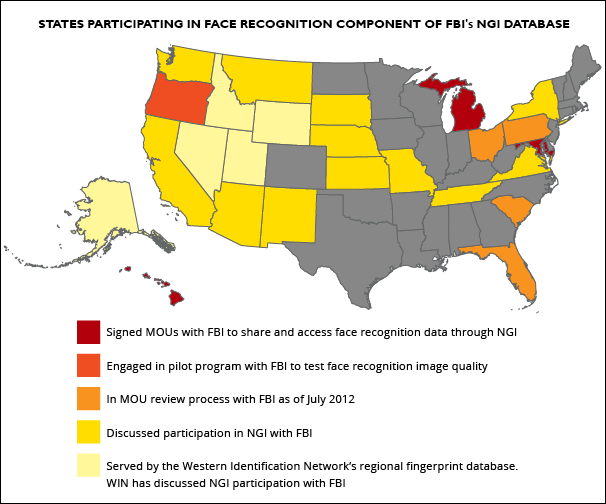


The EFF
Jennifer Lynch is a senior staff attorney with the Electronic
Frontier Foundation and works on open government, transparency and
privacy issues, including drones, automatic license plate readers and
facial recognition.
New documents released by the FBI show that the Bureau is well on its
way toward its goal of a fully operational face recognition database by
this summer.The EFF received these records in response to our Freedom of Information Act lawsuit for information on Next Generation Identification (NGI)—the FBI’s massive biometric database that may hold records on as much as one-third of the US population. The facial recognition component of this database poses real threats to privacy for all Americans.
What is NGI?
NGI builds on the FBI’s legacy fingerprint database—which already contains well over 100 million individual records—and has been designed to include multiple forms of biometric data, including palm prints and iris scans in addition to fingerprints and face recognition data. NGI combines all these forms of data in each individual’s file, linking them to personal and biographic data like name, home address, ID number, immigration status, age, race, etc. This immense database is shared with other federal agencies and with the approximately 18,000 tribal, state, and local law enforcement agencies across the United States.The records we received show that the face recognition component of NGI may include as many as 52 million face images by 2015. By 2012, NGI already contained 13.6 million images representing between 7 and 8 million individuals, and by the middle of 2013, the size of the database increased to 16 million images. The new records reveal that the database will be capable of processing 55,000 direct photo enrollments daily and of conducting tens of thousands of searches every day.
NGI will include non-criminal as well as criminal photos
One of our biggest concerns about NGI has been the fact that it will include non-criminal as well as criminal face images. We now know that FBI projects that by 2015, the database will include 4.3 million images taken for non-criminal purposes.Currently, if you apply for any type of job that requires fingerprinting or a background check, your prints are sent to and stored by the FBI in its civil print database. However, the FBI has never before collected a photograph along with those prints. This is changing with NGI. Now an employer could require you to provide a “mug shot” photo along with your fingerprints. If that’s the case, then the FBI will store both your face print and your fingerprints along with your biographic data.
In the past, the FBI has never linked the criminal and non-criminal fingerprint databases. This has meant that any search of the criminal print database (such as to identify a suspect or a latent print at a crime scene) would not touch the non-criminal database. This will also change with NGI. Now, every record—whether criminal or non—will have a “Universal Control Number” (UCN), and every search will be run against all records in the database. This means that even if you have never been arrested for a crime, if your employer requires you to submit a photo as part of your background check, your face image could be searched—and you could be implicated as a criminal suspect—just by virtue of having that image in the non-criminal file.
Read More @ Source
No comments:
Post a Comment